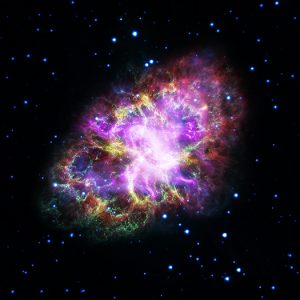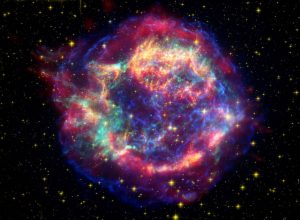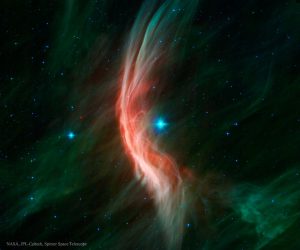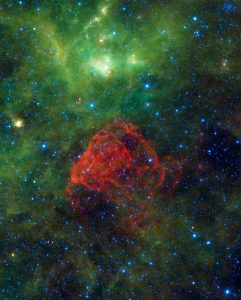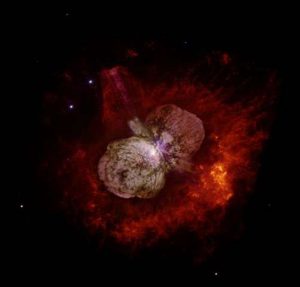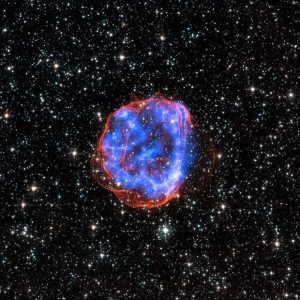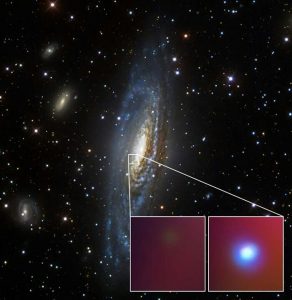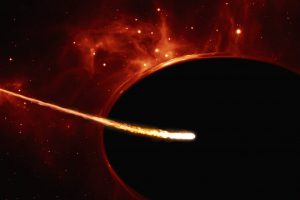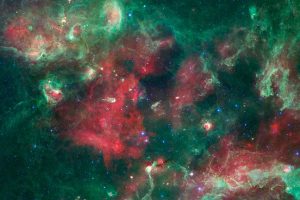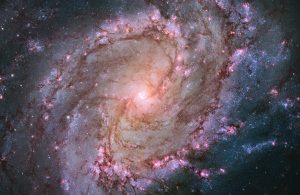esplosione di supernova
La Nebulosa del Granchio rivelata da grandi telescopi
Combinando dati ottenuti da grandi telescopi, il Very Large Array (VLA) nella banda radio, l’Osservatorio Chandra in banda X, il telescopio Hubble in luce visibile, il telescopio Spitzer nell’infrarosso e il telescopio spaziale XMM-Newton dell’ESA, gli astronomi hanno realizzato un’immagine straordinariamente dettagliata della Nebulosa del Granchio. Continua a leggere
L’Esplosione di Cassiopea A
Le stelle massicce che esplodono come supernove sono le fonti principali di elementi chimici pesanti nell’Universo. In particolare i nuclei atomici radioattivi vengono sintetizzati nelle calde regioni interne durante l’esplosione e possono essere utili per sondare i processi fisici non osservabili che danno inizio all’esplosione. Continua a leggere
Zeta Oph: Una Stella in Fuga
Come una nave che viaggia veloce in un oceano cosmico, la stella in fuga Zeta Ophiuchi produce l’onda d’urto interstellare a forma di arco ben evidente in questa bella immagine ripresa negli infrarossi dal telescopio Spitzer. Continua a leggere
Un’Antica Supernova
Circa 3700 anni fa gli abitanti della Terra potrebbero avere visto una nuova stella brillare in cielo. Quando si è affievolita ed è scomparsa dalla vista, probabilmente è stata dimenticata, finché i moderni astronomi non hanno trovato i suoi resti, chiamati Puppis A. Continua a leggere
SN2015bh: Una Stella che non vuole morire?
Le stelle massicce terminano la loro vita con esplosioni di supernova, eventi altamente energetici che possono essere brillanti come tutta la luce stellare delle galassie in cui avvengono. Tuttavia esistono eventi chiamati “supernove impostore” che, a dispetto della loro intensità, non rappresentano la morte di una stella. Continua a leggere
Una supernova subito dopo il botto
Osservazioni riprese poche ore dopo un’esplosione di supernova aiutano a fare chiarezza sul comportamento delle stelle subito prima della loro morte. Continua a leggere
La Bizzarra Supernova ‘Camaleonte’
“Siamo fatti di materia stellare” disse il famoso astronomo Carl Sagan. Le reazioni nucleari avvenute nelle antiche stelle hanno generato gran parte degli elementi che costituiscono il nostro corpo, il nostro pianeta, il nostro Sistema Solare. Quando le stelle esplodono come supernove, questi elementi vengono diffusi nello spazio. Continua a leggere
Un buco nero in rapida rotazione divora una stella
Si riteneva che il lampo luminoso straordinariamente brillante visibile in una galassia remota, chiamato ASASSN-15lh, fosse la più brillante supernova mai osservata. Ma nuove rilevazioni effettuate da vari osservatori, tra cui ESO, hanno messo in dubbio questa classificazione. Un gruppo di astronomi ha ipotizzato che la sorgente sia un evento ancora più estremo e molto raro: un buco nero in rapida rotazione che sta facendo a pezzi una stella imprudente che si è avvicinata troppo. Continua a leggere
Una supernova all’origine del Sistema Solare
Un team di ricercatori guidato da Yong-Zhong Qian dell’University of Minnesota School of Physics and Astronomy utilizzando nuovi modelli e analizzando meteoriti ha ipotizzato che una supernova di piccola massa abbia innescato gli eventi che hanno portato alla formazione del Sistema Solare. I risultati dello studio sono stati pubblicati su Nature Communications. Continua a leggere
Genesi Stellare nella Girandola del Sud
La bellezza della galassia a spirale barrata Messier 83 è svelata in tutta la sua gloria in questa immagine del telescopio Hubble. Le vivaci tonalità magenta e blu rivelano che la galassia risplende di formazione stellare. Conosciuta anche come Girandola del Sud, si trova a 15 milioni di anni luce di distanza nella costellazione dell’Idra. Continua a leggere
